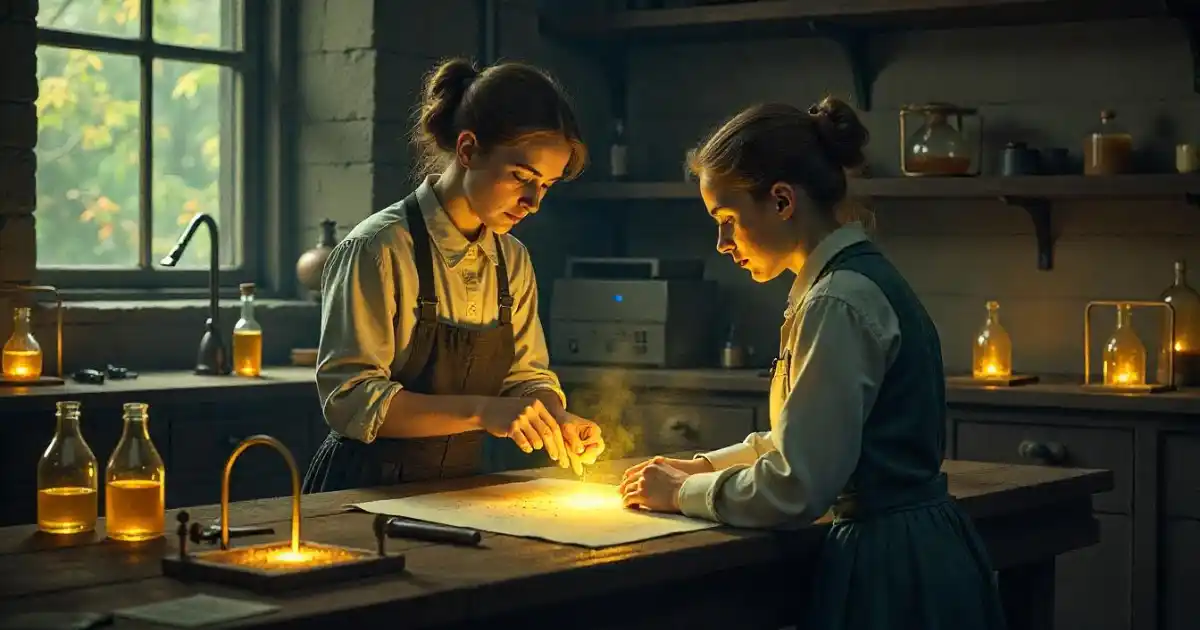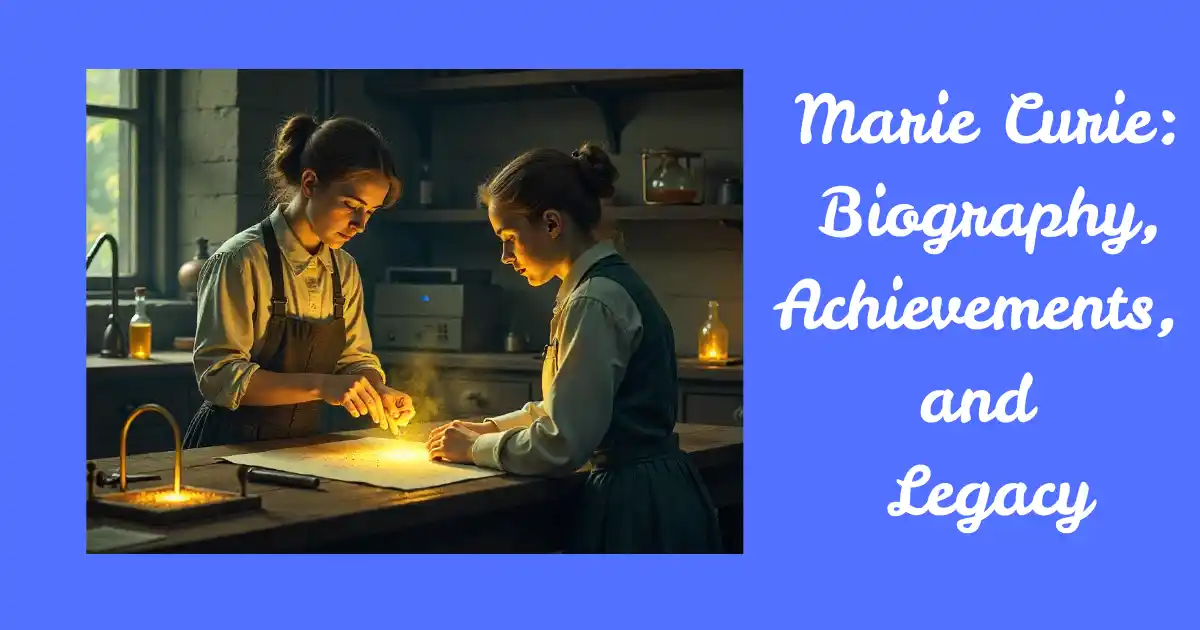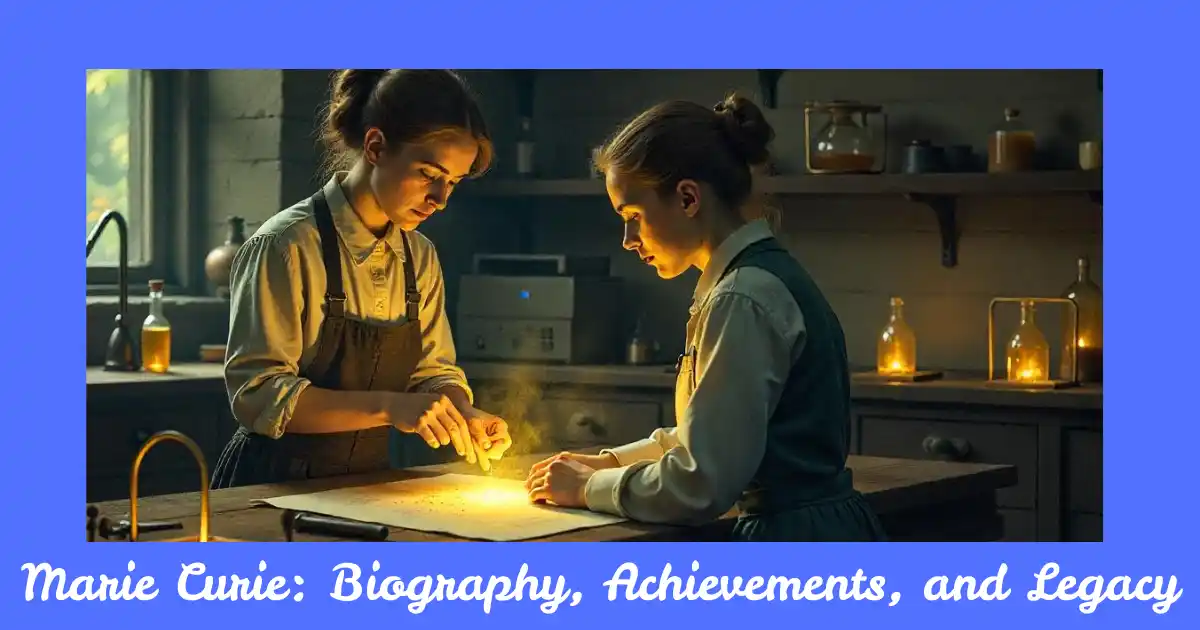Marie Curie is one of the most influential scientists in history, whose groundbreaking discoveries in radioactivity changed the course of modern science. Her remarkable achievements, from winning two Nobel Prizes to contributing to medical research during World War I, make her a symbol of perseverance, brilliance, and dedication.

This article explores her extraordinary journey—from her humble beginnings in Poland to her iconic status in global scientific history.
Marie Curie
“Life is not easy for any of us. But what of that? We must have perseverance and above all confidence in ourselves. We must believe that we are gifted for something and that this thing must be attained.”
Do you know who was the first woman to receive a Nobel Prize? Or the first person in history to achieve the remarkable feat of winning two Nobel Prizes? Do you know who is the only woman to receive two Nobel Prizes, and in two different scientific fields? The answer to all of these questions points to one extraordinary individual: Maria Salomea Skłodowska-Curie, more famously known as Marie Curie.
Read more – The Great Women of Bengal: Pioneers of Social Change U4L2
Early life
Marie Curie née Maria Sklodowska, was born in Warsaw on November 7, 1867, the daughter of a secondary-school teacher. From childhood she was remarkable for her prodigious memory, and at the age of 16 she won a gold medal on completion of her secondary education at the Russian lycée. Because her father, a teacher of mathematics and physics, lost his savings through bad investments, she had to take work as a teacher and, at the same time, took part clandestinely in the nationalist “free university,” reading in Polish to women workers. At the age of 18 she took a post as governess. From her earnings she was able to finance her sister Bronisława’s medical studies in Paris, with the understanding that Bronisława would in turn later help her to get an education.
Move to Paris, Pierre Curie, and the first Nobel Prize
In 1891, Skłodowska went to Paris and, now using the name Marie, began to follow the lectures of Paul Appell, Gabriel Lippmann, and Edmond Bouty at the Sorbonne. There she met many physicists who were already well known. Skłodowska worked far into the night in her student-quarters garret and virtually lived on bread and butter and tea. She came first in the licence examination of physical sciences in 1893. She began to work in Lippmann’s research laboratory and in 1894 was placed second in the licence examination of mathematical sciences. It was in the spring of that year that she met Pierre Curie.
Their marriage (July 25, 1895) marked the start of a partnership that was soon to achieve results of world significance, in particular the discovery of polonium (so called by Marie in honour of her native land) in the summer of 1898 and that of radium a few months later. Following Henri Becquerel’s discovery (1896) of a new phenomenon (which she later called “radioactivity”), Marie Curie, looking for a subject for a thesis, decided to find out if the property discovered in uranium was to be found in other matter. She discovered that this was true for thorium at the same time as G.C. Schmidt did.
Turning her attention to minerals, she found her interest drawn to pitchblende, a mineral whose activity, superior to that of pure uranium, could be explained only by the presence in the ore of small quantities of an unknown substance of very high activity. Pierre Curie then joined her in the work that she had undertaken to resolve this problem and that led to the discovery of the new elements, polonium and radium. While Pierre Curie devoted himself chiefly to the physical study of the new radiations.
Marie Curie struggled to obtain pure radium in the metallic state achieved with the help of the chemist André-Louis Debierne, one of Pierre Curie’s pupils. On the results of this research, Marie Curie received her doctorate of science in June 1903 and, with Pierre, was awarded the Davy Medal of the Royal Society. Also, in 1903, they shared with Becquerel the Nobel Prize for Physics for the discovery of radioactivity. The birth of her two daughters, Irène and Eve, in 1897 and 1904, did not interrupt Marie’s intensive scientific work. She was appointed lecturer in physics at the École Normale Supérieure for girls in Sèvres (1900) and introduced there a method of teaching based on experimental demonstrations. In December 1904 she was appointed chief assistant in the laboratory directed by Pierre Curie.
Death of Pierre and second Nobel Prize
The sudden death of Pierre Curie (April 19, 1906) was a bitter blow to Marie Curie, but it was also a decisive turning point in her career: henceforth she was to devote all her energy to completing alone the scientific work that they had undertaken. On May 13, 1906, she was appointed to the professorship that had been left vacant on her husband’s death; she was the first woman to teach in the Sorbonne. In 1908 she became titular professor, and in 1910 her fundamental treatise on radioactivity was published.
In 1911 she was awarded the Nobel Prize for Chemistry, for the isolation of pure radium. Throughout World War I, Marie Curie, with the help of her daughter Irène, devoted herself to the development of the use of X-radiography. In 1918 the Radium Institute, the staff of which Irène had joined, began to operate in earnest, and it was to become a universal centre for nuclear physics and chemistry. Marie Curie, now at the highest point of her fame and, from 1922, a member of the Academy of Medicine, devoted her researches to the study of the chemistry of radioactive substances and the medical applications of these substances.
Death
In 1934, Marie Curie died as a result of aplastic anemia caused by the action of radiation. Her contribution to physics had been immense, not only in her own work, the importance of which had been demonstrated by the award to her of two Nobel Prizes, but because of her influence on subsequent generations of nuclear physicists and chemists. Marie Curie, together with Irène Joliot-Curie, wrote the entry on radium for the 13th edition (1926) of the Encyclopædia Britannica.
In 1995 Marie Curie’s ashes were enshrined in the Panthéon in Paris; she was the first woman to receive this honour for her own achievements. Her office and laboratory in the Curie Pavilion of the Radium Institute are preserved as the Curie Museum.
[This passage/content is taken from the National Curriculum and Textbook Board (NCTB), Bangladesh English textbook for educational purposes only.]
© NCTB Bangladesh. All rights reserved to the original publisher.

Bangla Meanings of Important Words and Phrases
| Word/Phrase | Bangla Meaning |
| Nobel Prize | নোবেল পুরস্কার |
| Radioactivity | তেজস্ক্রিয়তা |
| Discovery | আবিষ্কার |
| Achievement | কৃতিত্ব |
| Scientist | বিজ্ঞানী |
| Prodigious memory | অসাধারণ স্মৃতিশক্তি |
| Licence examination | ডিগ্রী পরীক্ষায় উত্তীর্ণ হওয়া |
| Laboratory | গবেষণাগার |
| Governess | গৃহশিক্ষিকা |
| Isolation (of elements) | উপাদান পৃথকীকরণ |
| Aplastic anemia | অজীবক রক্তাল্পতা |
| Partnership | অংশীদারিত্ব |
| Sorbonne | ফ্রান্সের একটি বিখ্যাত বিশ্ববিদ্যালয় |
| Cladestinely | গোপনে |
| Mineral | খনিজ |
| Radium | রেডিয়াম (এক ধরনের তেজস্ক্রিয় উপাদান) |
| Polonium | পলোনিয়াম (একটি তেজস্ক্রিয় মৌল) |
| Medal | পদক |
| War | যুদ্ধ |
| X-radiography | এক্স-রে প্রযুক্তি |
Read more – Wangari Maathai: 5 Powerful Lessons from her Inspiring Life
Bangla Explanation – Paragraph-wise
Paragraph 1:
Marie Curie ছিলেন একজন অসাধারণ বিজ্ঞানী যিনি দু’টি ভিন্ন বিষয়ে নোবেল পুরস্কার পেয়েছেন। তিনি প্রথম নারী হিসেবে নোবেল পান এবং এখন পর্যন্ত একমাত্র নারী যিনি দুইটি বিজ্ঞান ক্ষেত্রে এই পুরস্কার অর্জন করেছেন।
Paragraph 2:
মেরি কুরি পোল্যান্ডের ওয়ারশ শহরে জন্মগ্রহণ করেন। তার পিতা ছিলেন গণিত ও পদার্থবিজ্ঞানের শিক্ষক। শৈশব থেকেই মেরি ছিলেন অসাধারণ মেধাবান। পরিবারিক আর্থিক অসুবিধার কারণে তিনি শিক্ষকতা শুরু করেন এবং তার বড় বোনকে প্যারিসে পড়াশোনার জন্য অর্থ সাহায্য করেন।
Paragraph 3:
১৮৯১ সালে তিনি প্যারিসে আসেন এবং Sorbonne বিশ্ববিদ্যালয়ে পড়াশোনা শুরু করেন। অনেক কষ্টের মধ্যেও তিনি ফিজিক্স ও ম্যাথেমেটিক্সে সেরা ফলাফল অর্জন করেন। এখানেই তার দেখা হয় পিয়ের কুরির সঙ্গে এবং তাদের গবেষণা শুরু হয়।
Paragraph 4:
তারা যৌথভাবে Polonium এবং পরে Radium আবিষ্কার করেন। Marie এই মৌলগুলো খনিজ পিচব্লেন্ড বিশ্লেষণের মাধ্যমে আবিষ্কার করেন। এই গবেষণার ভিত্তিতে Marie ও Pierre Nobel Prize পান।
Paragraph 5:
দুই কন্যা Irene ও Eve-এর জন্ম হলেও Marie তার গবেষণার ধারাবাহিকতা বজায় রাখেন। তিনি মহিলাদের জন্য শিক্ষা প্রচারে কাজ করেন এবং গবেষণাও চালিয়ে যান।
Paragraph 6:
১৯০৬ সালে Pierre দুর্ঘটনায় মারা গেলে Marie পুরোপুরি একা কাজ চালিয়ে যান এবং Sorbonne-এ প্রথম নারী অধ্যাপক হন। ১৯১১ সালে তিনি দ্বিতীয়বার Nobel Prize লাভ করেন।
Paragraph 7:
প্রথম বিশ্বযুদ্ধে তিনি মেয়ের সহায়তায় এক্স-রে প্রযুক্তি চিকিৎসায় প্রয়োগ করেন। পরে Radium Institute প্রতিষ্ঠিত হয় যেখানে ভবিষ্যতের অনেক বিজ্ঞানী তৈরি হন।
Paragraph 8:
১৯৩৪ সালে তেজস্ক্রিয়তার প্রভাবে aplastic anemia-তে মারা যান। কিন্তু তার অবদান পরবর্তী প্রজন্মের বিজ্ঞানীদের প্রভাবিত করে। তার কাজকে সম্মান জানাতে তাকে প্যানথিয়নে সমাহিত করা হয়।
Historical Events Related to Marie Curie
- Russian Occupation of Poland (19th Century)
Marie Curie was born in Warsaw in 1867, during a time when Poland was under Russian control. Educational opportunities, especially for women and Polish nationals, were heavily restricted, leading her to participate in underground (clandestine) education efforts. - Rise of Women’s Education Movements in Europe (Late 1800s)
Marie’s move to Paris in 1891 placed her in a progressive academic environment at the Sorbonne, where women were slowly gaining access to higher education—though still rare. - Discovery of Radioactivity (1896)
Henri Becquerel discovered radioactivity, which became the foundation of Marie and Pierre Curie’s groundbreaking work. This discovery launched the atomic age in physics and chemistry. - Discovery of Polonium and Radium (1898)
The Curies’ discovery of these two elements marked a monumental moment in scientific history, paving the way for future research in atomic structure, nuclear energy, and medical applications like cancer treatment. - First Nobel Prize (1903)
Marie Curie became the first woman to receive a Nobel Prize, jointly awarded with Pierre Curie and Henri Becquerel. This was a landmark event in the history of women’s participation in science. - Death of Pierre Curie (1906)
After her husband’s accidental death, Marie became the first female professor at the Sorbonne—breaking gender barriers in academia. - Second Nobel Prize (1911)
She won the Nobel Prize in Chemistry for isolating pure radium, becoming the first and only person to win Nobel Prizes in two scientific fields—a historic achievement unmatched even today. - World War I and X-Ray Technology (1914–1918)
During the war, Curie developed mobile X-ray units (“petites Curies”) and trained medical personnel, significantly aiding battlefield medicine. This was one of the earliest integrations of advanced science into wartime humanitarian aid. - Founding of the Radium Institute (1918)
The institute became a global center for research in radioactivity and nuclear science, influencing generations of scientists. - Enshrinement in the Panthéon (1995)
Marie Curie became the first woman honored in the Panthéon, Paris, for her own scientific contributions—recognizing her enduring legacy in both science and human history.
Read more – Marie Curie | Biography, Nobel Prize, Accomplishments
Literary Terms in the Passage
1. Metaphor (রূপক)
Explanation:
A metaphor is a figure of speech where one thing is said to be another to imply a similarity without using “like” or “as.” It is an indirect comparison.
In the Passage:
“Life is not easy for any of us…” – Here, life is compared to a struggle, but the word “struggle” is not used directly. This is a metaphor, implying that life is full of difficulties.
Bangla Example:
“জীবন একটা যুদ্ধ।” – এখানে জীবনকে সরাসরি যুদ্ধ বলা হয়েছে, যদিও তা আসলে যুদ্ধ নয়। এটি একটি রূপক (Metaphor)।
2. Allusion (ইঙ্গিতপূর্ণ উল্লেখ বা সাংস্কৃতিক উল্লেখ)
Explanation:
An allusion is a brief and indirect reference to a person, place, thing, or idea of historical, cultural, literary, or political significance. It does not describe in detail but relies on the reader’s knowledge.
In the Passage:
The mention of Sorbonne, Nobel Prize, and Radium Institute are allusions. These refer to well-known educational and scientific institutions and assume the reader knows their importance.
Bangla Example:
“তিনি রাবীন্দ্রনাথের মত শান্তি খুঁজছিলেন।” – এখানে রবীন্দ্রনাথ নামটি ব্যবহার করে শান্তির একটি প্রতীকী ব্যক্তিত্বকে নির্দেশ করা হয়েছে। এটি একটি Allusion (ইঙ্গিতপূর্ণ উল্লেখ)।
3. Symbolism (প্রতীকধর্মিতা)
Explanation:
Symbolism is the use of symbols to signify ideas and qualities by giving them meanings different from their literal sense. A symbol is often a physical object representing something abstract.
In the Passage:
Radium and polonium symbolize more than just elements. They represent scientific discovery, national pride (especially Poland), and human progress.
Bangla Example:
“পৃথিবীর প্রথম আলো” – এখানে আলো প্রতীক হিসেবে ব্যবহার হয়েছে জ্ঞান বা বুদ্ধির। এটি প্রতীকধর্মিতা (Symbolism)।

Answer the following Short Questions
- Who was the first woman to receive a Nobel Prize?
- What nationality was Marie Curie by birth?
- Which two elements did Marie Curie help discover?
- Where did Marie Curie study in Paris?
- In which year did she win her first Nobel Prize?
- What was Marie Curie’s husband’s name?
- What caused Marie Curie’s death in 1934?
- Which subject did Marie Curie first teach at the Sorbonne?
- During which war did Marie Curie work on X-ray technology?
- Where are Marie Curie’s ashes preserved?

